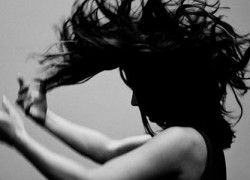
Nowadays, it seems like we cannot help ourselves from taking hundreds of photographs in our daily life. We don’t notice anymore how this media is strongly altering our perceptions. Humans see the world mainly through a screen, and this idea of limitation is what Gregory Lorenzutti is trying to explore in his new dance performance called Mechanical Eye.
The title is a reference to Dziga Vertov’s 1929 experimental film Man With A Movie Camera, which pushes back the idea of identity through the documentation of urban life. The Brazilian choreographer, based in Melbourne, gives us his own perspective on the topic by mixing both of his passions – dance and photography. And the Mezzanine Gallery at Chapel of the Chapels (Prahran) is the perfect place to be immersed in this experience. Indeed, it’s not a traditional dark theatre, but a white and empty place, which looks like the perfect replica of a photography studio.
Everything seems immaculate, from the bare walls to the white, light and silky costumes of the five dancers, standing in a minimalist décor. Barefoot, the hair down, a sensation of freedom and simplicity is present. Only a polaroid camera is put on the floor, to remind us that images are everywhere.
There is not really a beginning or an end to this performance, which already started when we arrived in the room. The movements are light and precise, and often the dancers execute the same dance moves frenetically and repetitively, as if they had no control over them. The human body is thus seen as a machine, trapped inside the camera lens. A huge contrast is present between the agitated movements and the supposedly stillness of photography.
Each dancer floats in his own world, as if he was concentrated only on his own self. Five big white panels are allocated in the room, one for each dancer who seem to be stuck in his frame. Indeed, the choreography is representing the act of taking a photograph – we can easily observe the geometrical decomposition of the body movements, as if each move was fractured in a multitude of others. The performance can refer to the work of Muy Bridge, and its photographic studies on motion.
“By seeing the world through the filter of our beliefs we constantly frame our lives by choosing to narrowing our vision” says Maud Léger, one of the dancers. Questioning identity and behaviour, Lorenzutti’s work is informing us about the power of photography in our daily movements. We see ourselves only through images, and this captivating and hypnotic performance makes us wonder about this particular vision we have on ourselves.
Finally, the show plays indubitably on time and space. At the end of the performance, the dancers stop to take a real photograph of one of them, using the polaroid camera. The time freezes while it captures a moment that will stay forever. This form of immortality is represented through the lack of mise-en-scène and the repetition in the dancer’s actions. Even when the show is finished, the portrait stays still on the floor.

